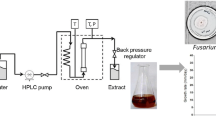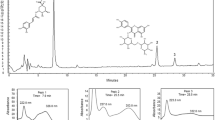Abstract
The mung bean (Vigna radiata) is an important food crop with preventative effects against human diseases. The anti-allergic activities of mung bean sprouts of different lengths were evaluated by assaying in vivo antipruritic activity and in vitro hyaluronidase inhibitory effects. After 48 h of growth, sprouts were determined to have the best activity and extracted with petroleum (PeF), ethyl acetate (EaF), and n-butanol (nBF). The active EaF extracts were further assayed for in vivo effects on compound 48/80-induced mast cell degranulation and histamine release, as well as the anti-dinitrophenyl (DNP) IgE-induced passive cutaneous anaphylaxis (PCA) reaction. The main chemical constituents were further analyzed by UV spectrophotometry and high-performance liquid chromatography with tandem mass spectrometric detection (LC/MS/MS). EaF significantly protected against compound 48/80-induced mast cell degranulation and histamine release, and PCA. Flavonoids were determined to be the main contributors to the anti-allergic activity of the EaF extracts.
Similar content being viewed by others
References
Lee SJ, Lee JH, Lee HH, Lee S, Kim SH, Chun T, Imm JY. Effect of mung bean ethanol extract on pro-inflammtory cytokines in LPS stimulated macrophages. Food Sci. Biotechnol. 20: 519–524 (2011)
Jom KN, Frank T, Engel KH. A metabolite profiling approach to follow the sprouting process of mung beans (Vignaradiata). Metabolomics 7: 102–117 (2011)
Tang DY, Dong YM, Ren HK, Li L, He CF. A review of phytochemistry, metabolite changes, and medicinal uses of the common food mung bean and its sprouts (Vignaradiata). Chem. Cent. J. 8: 4 (2014)
Lai F, Wen Q, Li L, Wu H, Li X. Antioxidant activities of water-soluble polysaccharide extracted from mung bean (Vigna radiata L.) hull with ultrasonic assisted treatment. Carbohyd. Polym. 81: 323–329 (2010)
Wang S, Lin J, Ye M, Ng TB, Rao P, Ye X. Isolation and characterization of a novel mung bean protease inhibitor with anti-pathogenic and antiproliferative activities. Peptides 27: 3129–3136 (2006)
Tang DY, Dong YM, Guo N, Li L, Ren HK. Metabolomic analysis of the polyphenolsingermina-tingmung beans (Vigna radiata) seeds and sprouts. J. Agr. Food Chem. 94: 1639–1647 (2014)
Wang Y. Study on the dynamic change of total flavonoids content and its antioxidant function in germinative mung bean. Master’s thesis, Jilin Agricultural University, Changchun, China (2011)
Alber G, Miller L, Jelsema C, Varin-Blank N, Metzger H. Structure/function relationships in the mast cell high-affinity receptor for IgE (FceRI): Role of cytoplasmic domains. J. Biol Chem. 266: 22613–22620 (1991)
Wershil BK, Galli SJ. The analysis of mast cell function in vivo using mast celldeficient mice. Adv. Exp. Med. Biol. 347: 39–54 (1994)
Koibuchi Y, Ichikawa A, Nakagawa M, Tomita K. Binding of active components of compound 48/80 to rat peritoneal mast cells. Eur. J. Pharmacol. 115: 171–177 (1985)
Allansmith MR, Baird RS, Ross RN, Barney NP, Bloch KJ. Ocular anaphylaxis induced in the rat by topical application of compound 48/80. Dose response and time course study. Acta Ophthalmol. 192: 145–153 (1989)
Aridor M, Traub LM, Sagi-Eisenberg R. Exocytosis in mast cells by basic secretagogues: Evidence for direct activation of GTP-binding proteins. J. Cell Biochem. 111: 909–917 (1990)
Wershil BK, Merkori YA, Murakami T, Galli SJ. 125I-fibrin deposition in IgE dependent immediate hypersensitivity reaction in mouse skin: Demonstration of the role of mast cells using genetically mast cell-deficient mice locally reconstituted with cultured mast cells. J. Immunol. 139: 2605–2614 (1987)
Reissig JL, Strominger JL, Leloir LF. A modified colorimetric method for the estimation of N-acetylamino sugars. J. Biol. Chem. 217: 959–966 (1955)
Hu YM, Zhong ZD. Study on effect of Ma Chi Xian extract for the rat foot itch threshold induced by histamine phosphate. Chin. J Ethnomed. Ethnopharm. 6: 34–35 (2013)
Jung HS, Kim MH, Gwak NG, Im YS, Lee KY, Sohn Y, Choi H, Yang WM. Antiallergic effects of Scutellaria baicalensis on inflammation in vivo and in vitro. J. Ethnopharmacol. 141: 345–349 (2012)
Kakegawa H, Matsumoto H, Satoh T. Inhibitory effects of some natural products on the activation of hyaluronidase and their anti-allergic actions. Chem. Pharm. Bull. 40: 1439–1442 (1992)
Chang CC, Yang MH, Wen HM, Chern JC. Estimation of total flavonoid content in propolis by two complementary colorimetric methods. J. Food Drug Anal. 10: 178–182 (2002)
Fang ZX, Zhang YH, Lü Y, Ma GP, Chen JC, Liu DH, Ye XQ. Phenolic compounds and antioxidant capacities of bayberry juices. Food Chem. 113: 884–888 (2009)
Fang DJ, Zhao RQ, Zhang XJ. Determination of total carbohydrate and uronic acid contents in polysaccharides from Poria cocos. IITCM 28: 42–44 (2011)
Boyce JA. Mast cells: Beyond IgE. J. Allergy Clin Immun. 111: 24–32 (2003)
Kalesnikoff J, Galli SJ. New developments in mast cell biology. Nat. Immunol. 9: 1215–1223 (2008)
Shin HY, Na HJ, Moon PD, Shin T, Shin TY, Kim SH, Hong SH, Kim HM. Inhibition of mast cell-dependent immediate-type hypersensitivity reactions by purple bamboo salt. J. Ethnopharmacol. 91: 153–157 (2004)
Lu Y, Yang JH, Li X, Hwangbo K, Hwang SL, Taketomi Y, Murakami M, Chang YC, Kim CH, Son JK, Chang HW. Emodin, a naturally occurring anthraquinone derivative, suppresses IgE-mediated anaphylactic reaction and mast cell activation. Biochem. Pharmacol. 82: 1700–1708 (2011)
Lu Y, Li Y, Jin M, Yang JH, Li X, Chao GH, Park HH, Park YN, Son JK, Lee E, Chang HW. Inula japonica extract inhibits mast cell-mediated allergic reaction and mast cell activation. J. Ethnopharmacol. 43: 151–157 (2012)
Jessy E, Mathew KK, Srinivasan VD, Alex J. Mast cell stabilizing effects of Sphaeranthus indicus. J. Ethnopharmacol. 122: 394–396 (2009)
Venkatesh P, Mukherjee PK, Kumar SN, Nema NK, Bandyopadhyay A, Fukui H Mizuguchi H. Mast cell stabilization and anti-histaminic potentials of Curculigo orchioides rhizomes. J. Ethnopharmacol. 126: 434–436 (2009)
Author information
Authors and Affiliations
Corresponding author
Rights and permissions
About this article
Cite this article
Li, L., Li, Mh., Ren, Hk. et al. Anti-allergic effects and related active constituents of mung bean (Vignaradiatus Linn) sprouts. Food Sci Biotechnol 25, 553–559 (2016). https://doi.org/10.1007/s10068-016-0077-8
Received:
Revised:
Accepted:
Published:
Issue Date:
DOI: https://doi.org/10.1007/s10068-016-0077-8




